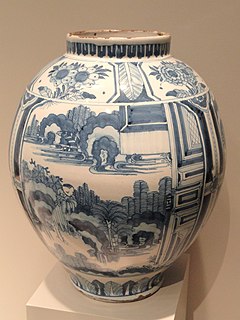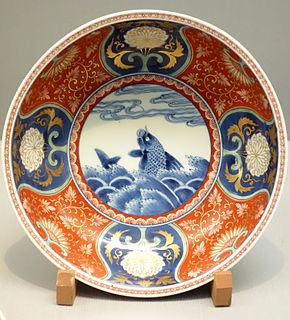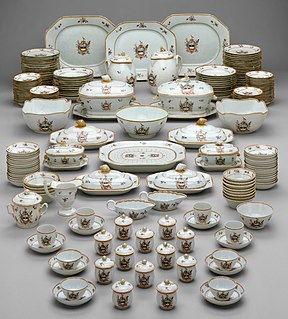


Chinese porcelain in European painting is known from the 16th century, following the importation of Chinese porcelain wares into Europe.



Chinese porcelain in European painting is known from the 16th century, following the importation of Chinese porcelain wares into Europe.

In Italy, the first known depiction of Chinese porcelain bowls is from The Feast of the Gods by Giovanni Bellini (1514). [1] The style of the bowls is that of the Ming dynasty blue and white porcelain type, maybe examples of which are known to have been exported in Persia, Syria and Egypt. [1] The painting by Bellini was a request by Duke Alfonso I d'Este, who was known for his interest in Chinese porcelain. It seems that Bellini found samples of the Chinese ware not through trade, but among diplomatic gifts received by Venice from the Mamluke Sultans in 1498 (gift to Doge Barbarigo), and in 1498 and 1508 (gift to the Signoria). [1]
Some earlier examples are known though, although it is unclear if they are Chinese or Islamic prototypes, as in the Madonna and Child by Francesco Benaglio (1460–70), or the Adoration of the Magi by Andrea Mantegna (1495–1505). [1]
In the 16th century, numerous other painters would use Chinese porcelain in their paintings, especially Dutch ones. This trend was related to the direct importation of Chinese porcelain to Europe, through what is known as "Carrak" trade, hence the name Kraak porcelain. [2] [3]
French painters, such as François Desportes and Paul Gauguin, also represented Chinese bowls in their still-life paintings. Some like Jacques Linard in 1627 even painstainkingly reproduced Chinese writing, in Les cinq sens et les quatre éléments , 1627. [4] [5]
This artistic trend coinciding with the fashion for Chinese porcelain in Europe in the 17th–18th century, which led to the development of a local porcelain industry initially highly imitative of Chinese wares, as seen in French porcelain.

In the history of seventeenth-century trade, few things can compete with the prominent position of porcelain. Before the discovery of its making technique in the West, commercial activity between Europe and China was the only way to possess them. During the seventeenth century, the Dutch Republic came to the fore in the realm of porcelain trading. This history was tightly related to the history of the Dutch East India Company. As a monopoly in the early-modern Europe-Asia trade, the Dutch East India Company acts as a mediator between the two cultures and imports tons of porcelain along with other commodities like spices, silk, and tea. [6] Since then, Chinese ceramic was not the exclusive luxury that only appeared in the upper class's mansion but became increasingly common in the domestic setting of the relatively humble household. [7]

Although the imported Chinese ceramics gains its popularity among wealthy merchants, the erudite scholars and philosophers are not satisfied merely with the commercial value of the porcelain. For them, the country and the civilization that created this fascinating material culture are the core of the interest. The appeal of China is deeply rooted in a long western tradition that may begin with the renowned Italian explorer Marco Polo. [8] This impression of China was reinforced by the exotic Chinese goods and luxuries that appeared in Europe, such as spices, silk, tea, and porcelain. Motivated by the splendid material culture, intellectuals ceaselessly explore Chinese civilisation. [9] This positive view of Chinese civilization also existed among the Dutch early-modern authors. For instance, scholars like Willem ten Rhijne, Peter van Hoorn, and Joost van den Vondel demonstrate strong interests in sinology and actively spread their thoughts through their books. This “Chinese fever” culminated with the first Dutch translation of Confucius in 1675. [10] Intellectuals’ taste could influence artists to a large extent since they are also important patrons of art. Although whether the artists are able to understand the cultural connotations of Chinese porcelains is quite ambiguous, the wave of the chinoiserie may permeate into the artistic group. [11] Chinese porcelain represents not only advanced craftsmanship and technology but also the symbol of civilization that is far away from Europe.

Meanwhile, the relatively opened art market and the distinct status of the artists in the Dutch Republic give a chance to artists to explore their own interest. Thus, still-life painters are mediators who seize the commodity, which is highly esteemed by society and represent it in their painting. [12] And in a prosperous commercial society, the value of the goods resides in its marketing price. Under the hegemonic Dutch economy, everything obeys the law of the business, including art. [13] In this sense, porcelain traded by Dutch East India company was a good choice for the artists to contain in their still-life paintings considering its social and economic connotation.

Moreover, the porcelain in Dutch still-life painting demonstrates how the material culture circulated and interacted around the world in the seventeenth century. This circulating process is also the process of domesticating the otherness. Like the connotations embedded in Juriaen van Streek’s painting Still Life with a Moor and Porcelain Vessels, these commodities and even human beings depicted in the painting come from completely different continents or cultures. The foreign material culture here is used to articulate the local identity of the Dutch. [14]

Delftware or Delft pottery, also known as Delft Blue, is a general term now used for Dutch tin-glazed earthenware, a form of faience. Most of it is blue and white pottery, and the city of Delft in the Netherlands was the major centre of production, but the term covers wares with other colours, and made elsewhere. It is also used for similar pottery, English delftware.

A still life is a work of art depicting mostly inanimate subject matter, typically commonplace objects which are either natural or man-made.

Imari ware is a Western term for a brightly-coloured style of Arita ware Japanese export porcelain made in the area of Arita, in the former Hizen Province, northwestern Kyūshū. They were exported to Europe in large quantities, especially between the second half of the 17th century and the first half of the 18th century.

Chinese export porcelain includes a wide range of Chinese porcelain that was made (almost) exclusively for export to Europe and later to North America between the 16th and the 20th century. Whether wares made for non-Western markets are covered by the term depends on context. Chinese ceramics made mainly for export go back to the Tang dynasty if not earlier, though initially they may not be regarded as porcelain.

Kraak ware or Kraak porcelain is a type of Chinese export porcelain produced mainly in the late Ming Dynasty, in the Wanli reign (1573–1620), but also in the Tianqi (1620–1627) and the Chongzhen (1627–1644). It was among the first Chinese export wares to arrive in Europe in mass quantities, and was frequently featured in Dutch Golden Age paintings of still life subjects with foreign luxuries.

"Blue and white pottery" covers a wide range of white pottery and porcelain decorated under the glaze with a blue pigment, generally cobalt oxide. The decoration is commonly applied by hand, originally by brush painting, but nowadays by stencilling or by transfer-printing, though other methods of application have also been used. The cobalt pigment is one of the very few that can withstand the highest firing temperatures that are required, in particular for porcelain, which partly accounts for its long-lasting popularity. Historically, many other colours required overglaze decoration and then a second firing at a lower temperature to fix that.

Hard-paste porcelain, sometimes "true porcelain", is a ceramic material that was originally made from a compound of the feldspathic rock petuntse and kaolin fired at very high temperature, usually around 1400 °C. It was first made in China around the 7th or 8th century, and has remained the most common type of Chinese porcelain.

Dutch art describes the history of visual arts in the Netherlands, after the United Provinces separated from Flanders. Earlier painting in the area is covered in Early Netherlandish painting and Dutch and Flemish Renaissance painting.

The art of the Low Countries consists of painting, sculpture, architecture, printmaking, pottery and other forms of visual art produced in the Low Countries, and since the 19th century in Belgium in the southern Netherlands and the Netherlands in the north.

Carpets of Middle-Eastern origin, either from Anatolia, Persia, Armenia, Azerbaijan, the Levant, the Mamluk state of Egypt or Northern Africa, were used as decorative features in Western European paintings from the 14th century onwards. More depictions of Oriental carpets in Renaissance painting survive than actual carpets contemporary with these paintings. Few Middle-Eastern carpets produced before the 17th century remain, though the number of these known has increased in recent decades. Therefore, comparative art-historical research has from its onset in the late 19th century relied on carpets represented in datable European paintings.

Vermeer's Hat: The Seventeenth Century and the Dawn of the Global World is a book by the Canadian historian Professor Timothy Brook, in which he explores the roots of world trade in the 17th century through six paintings by the Dutch Golden Age painter Johannes Vermeer. It focuses especially on growing ties between Europe and the rest of the world and the impact of China on the world, during what Brook sees as an "age of innovation" and improvisation.

Het Schilder-Boeck or Schilderboek is a book written by the Flemish writer and painter Karel van Mander first published in 1604 in Haarlem in the Dutch Republic, where van Mander resided. The book is written in 17th-century Dutch and its title is commonly translated into English as 'The Book of Painters' or 'The Book of Painting' and sometimes as 'The Book on Picturing'. Het Schilder-Boeck consists of six parts and is considered one of the principal sources on the history of art and art theory in the 15th and 16th century Low Countries. The book was very well received and sold well. Karel van Mander died two years after its publication. A second posthumous edition, which included a brief, anonymous biography of van Mander was published in 1618. This second edition was translated by Hessel Miedema into English and published in 1994-1997 together with a facsimile of the original and 5 volumes of notes on the text.

Still Life with a Chinese Porcelain Jar is a 1669 oil painting by Dutch artist Willem Kalf, located in the Indianapolis Museum of Art, which is in Indianapolis, Indiana. It is a sumptuous still life displaying the sort of costly wares that flowed through the Netherlands during its heyday as a trade center.

Joanna Woodall is an art historian at the Courtauld Institute of Art, London, where she is a specialist in portraiture and Netherlandish art.

Peter van Boucle was a Flemish Baroque painter who worked for a large part of his life in Paris where he was one of the most prolific Flemish still life painters.

Ceramic art is art made from ceramic materials, including clay. It may take forms including artistic pottery, including tableware, tiles, figurines and other sculpture. As one of the plastic arts, ceramic art is one of the visual arts. While some ceramics are considered fine art, as pottery or sculpture, most are considered to be decorative, industrial or applied art objects. Ceramics may also be considered artefacts in archaeology. Ceramic art can be made by one person or by a group of people. In a pottery or ceramic factory, a group of people design, manufacture and decorate the art ware. Products from a pottery are sometimes referred to as "art pottery". In a one-person pottery studio, ceramists or potters produce studio pottery.

Japanese export porcelain includes a wide range of porcelain that was made and decorated in Japan primarily for export to Europe and later to North America, with significant quantities going to south and southeastern Asian markets. Production for export to the West falls almost entirely into two periods, firstly between the 1650s and 1740s, and then the period from the 1850s onwards.

The Miracles of St. Francis Xavier is a large altarpiece painted by Peter Paul Rubens in 1617 or 1618. It was originally commissioned by the Jesuits in Antwerp for their church, now known as the St. Charles Borromeo Church. It is now in the Kunsthistorisches Museum in Vienna. The painting depicts the miracles worked by St. Francis Xavier during his mission to Asia and includes a large variety of figures from Asia and Africa, as well as the destruction of a Hindu idol in the background. Rubens also painted a companion piece, The Miracles of St. Ignatius of Loyola.
The Golden Age of Flanders, or Flemish Golden Age, is a term that has been used to describe the flourishing of cultural and economic activities of the Low Countries around the 16th century. The term Flanders in the 1500s referred to the entire Habsburg Netherlands within the Burgundian Circle of the Holy Roman Empire and inclusive of modern-day Belgium, the Netherlands, and Luxembourg. Its political capital was Brussels, while the financial-economic centre was Antwerp. Other major artistic and cultural centres of the period included Bruges, Ghent, Mechelen and Leuven. It is also grouped with the Dutch Golden Age, a more common term used primarily in reference to the Dutch Republic in the 1600s, within a "Flemish and Dutch golden age" covering the period from the late 15th to the 17th century.
● Gerritsen, Anne, and Mcdowall, Stephen. “Material Culture and the Other: European Encounters with Chinese Porcelain, ca. 1650-1800,” Journal of World History, Vol. 23, No.1, Special Issue: Global China (March 2012): 87-113.
● Honig, Elizabeth Alice. “Making Sense of Things: On the Motives of Dutch Still Life,” Anthropology and Aesthetics, No. 34 (Autumn, 1998): 166-183.
● Jörg, Christiaan J.A. Porcelain and the Dutch China Trade, The Hague: Martinus Nijhoff, 1982.
● Kaufmann, Thomas DaCosta. "The 'Netherlandish Model'? Netherlandish Art History As/and Global Art History." Nederlands Kunsthistorisch Jaarboek (NKJ) / Netherlands Yearbook for History of Art 66 (2016): 272-95.
● Schama, Simon. The Embarrassment of Riches : An Interpretation of Dutch Culture in the Golden Age. London: Collins, 1987.
● Weststeijn, Thijs. “Cultural Reflections on Porcelain in the 17th-century Netherlands”, Chinese and Japanese Porcelain for the Dutch Golden Age, Amsterdam: Rijksmuseum Amsterdam, (2014): 213-268.
● Weststeijn, Thijs. "Introduction: Global Art History and the Netherlands." Nederlands Kunsthistorisch Jaarboek (NKJ) / Netherlands Yearbook for History of Art 66 (2016): 6-27.